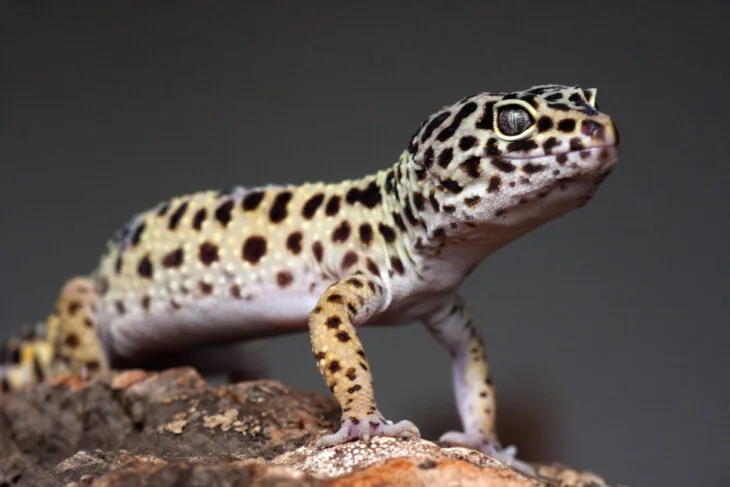
Crickets are a primary
Leaving crickets in your leopard gecko’s
First-time keepers may find taking care of a leopard gecko daunting. By identifying causes of problems and scheduling feeding times for your pet reptile, you will have a more pleasant experience handling your pet geckos with live cricket feedings.
Table of Contents
Why Leaving Crickets Overnight is Bad for Leopard Geckos
Crickets are ideal live feeder insects (click here to learn why), which are highly nutritious for your pet reptiles. However, because these are live insects, they can be a source of distress for your pet if they’re left uneaten for the night.
Crickets can bite if they get hungry
Under normal circumstances, crickets don’t attack larger predators. However, once they become hungry, it is possible that crickets may attack leopard geckos. We show you what crickets can do to leopard geckos here.
Although crickets have tiny teeth, they can easily bite through your pet gecko’s delicate skin. These bites could potentially leave your leos vulnerable to bacterial infection.
Crickets leave a terrible smell
With their small builds, these critters can escape from your gecko and hide in tiny crevices within your pet’s vivarium.
Left unattended, these live insects may die in these spots and rot. If their remains are not entirely removed, it can leave a foul smell in your leos’
Novice pet keepers may want to indulge their pet reptiles with crickets to keep them well fed throughout the time they are away.
When these insects remain uneaten and die in these enclosures, pet owners must remove everything from the
The
Crickets become a stressor
Uneaten live crickets jump around the
They don’t keep live insects around so they can eat it later on. Being in an enclosed
Crickets can be unruly and are not easily intimidated, even by large predators such as leopard geckos. Moreover, your pet reptiles may need to keep defending themselves from these critters’ bites and distractions.

Crickets lose their nutritional value
Feeding your geckos with gut-loaded crickets is essential for their daily nutritional needs. Two days of gut-loading crickets will yield sufficient calcium to phosphorus ratio and vitamin A fit for carnivore requirements.
To get optimum nutritional value from live feeds, your leopard gecko must consume the insect soon after being dusted with calcium. Crickets frequently groom, and the dust won’t stay on for long.
Even if your leopard gecko eats the crickets that have been in the
How to Keep Crickets from Hiding in Your Leopard Gecko’s Tank
There are some practical ways to keep live crickets from hiding in your leopard gecko’s enclosure and potentially harming them in the long run.
When feeding time comes around, you can protect your leos from unwanted consequences with a little careful planning.
Feed only one to two insects at a time
Monitor your gecko’s feeding behavior. A typical leo would consume one or two crickets per meal, while younger geckos tend to eat more. A one-year-old gecko will only need to eat four times a week.
Place leopard geckos in a different tank for feeding
It is much easier to keep track of the crickets you feed your pet reptile with a smaller feeding
Your leopard geckos will then immediately be able to see their
If you’re going away, feed your geckos ahead of time
Leaving crickets with your geckos unsupervised could be harmful to your pet. If you have a scheduled trip the following day, it’s best to feed your leopard gecko ahead of time.
For trips lasting longer than a few days, you need a reliable pet caretaker to feed your gecko appropriately and on time.
Remove the cricket’s hind legs
Removing a cricket’s hind legs limits its movement and prevents it from hiding in tiny crevices in your pet gecko’s
You can see how to do it in this video:
How to Remove Crickets from Your Leopard Gecko’s Tank
Catching crickets in your pet’s tank can be hard work. Here are some ways you can take out crickets after your pet gecko is full:
- Since crickets love to hide in dark and small spaces, a toilet paper roll makes an excellent hideout for these insects. After leaving the cardboard roll for about 15 to 30 minutes, you can take it out and shake out the crickets into a bag.
- Working similarly to cardboard tissue rolls, you can use cardboard egg crates. Wait for 15 to 30 minutes before taking them out of the
tank . Then shake the crickets out in a bag or back to the cricket enclosure.
- Use a small, clear plastic cup, like the ones that come with kids’ cough syrup. Use the cup to chase the insect to a corner and scoop it out of the
tank .
Simple Ways to Prevent Crickets from Munching On Your Leopard Gecko
Agitated and hungry crickets could target your leopard gecko if they stay in your pet’s
- Place potatoes, carrot peels, or leafy greens in small amounts in a container. Leave this in the
tank while your pet lizard is feeding.
- If vegetables are not available, use small portions of bananas, apples, or oranges placed in a small container. This is a staple
food for crickets, so they can feed on these instead of biting your pet leopard gecko.
Conclusion
Crickets are essential for your pet’s diet, and are a highly recommended live feed for leopard geckos because of their high nutritional value.
However, it is good practice to remove leftover insects after each feed. Proper feeding scheduling and identification of your gecko’s eating behavior will help you prevent damage and stress caused by crickets.
- Enchi Ball Python: A Unique and Stunning Morph of Python regius - March 27, 2025
- Emerald Tree Monitor: The Enigmatic Green Guardian of the Rainforest - March 26, 2025
- The Egyptian Cobra (Naja haje): A Fascinating Serpent - March 25, 2025
